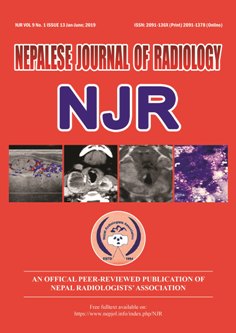Prevalence of Congenital Anomalies in Oligohydramnios: A Hospital Based Study in Western Nepal
DOI:
https://doi.org/10.3126/njr.v9i1.24807Keywords:
Amniotic Fluid, Fetal Development, Gestational Age, PregnancyAbstract
Introduction: Amniotic fluid serves as a cushion for growing fetus. Oligohydramnios is decreased amount of amniotic fluid and is associated with increased incidence of congenital anomalies. The aim of this study was to detect the prevalence of congenital anomalies in oligohydramnios
Methods: Singleton pregnancy irrespective of gestational age with amniotic fluid deepest vertical pocket (DVP) of less than two centimeters was included in the study. Grading of oligohydramnios was done as mild and severe. Detailed anomaly scan was done to look for any congenital malformations. Congenital anomalies were confirmed with post natal findings.
Results: There were 60 pregnant women with amniotic fluid index less than two centimeters with respect to deepest vertical pocket. Congenital anomalies were detected in 18.33% pregnant women with oligohydramnios. In patients with severe oligohydramnios 33.33% had congenital anomalies. Renal anomalies were the most common anomalies in our study followed by musculoskeletal anomalies. Central nervous system, gastrointestinal and cardiac and anomalies were also common in association with oligohydramnios.
Conclusion: Our study showed that various congenital anomalies are associated with oligohydramnios and incidence of anomalies increases with increased severity of oligohydramnios. Hence, detailed ultrasound scan should be done to look for congenital malformations whenever oligohydramnios is encountered.
Downloads
Downloads
Published
How to Cite
Issue
Section
License
This license enables reusers to distribute, remix, adapt, and build upon the material in any medium or format, so long as attribution is given to the creator. The license allows for commercial use.




